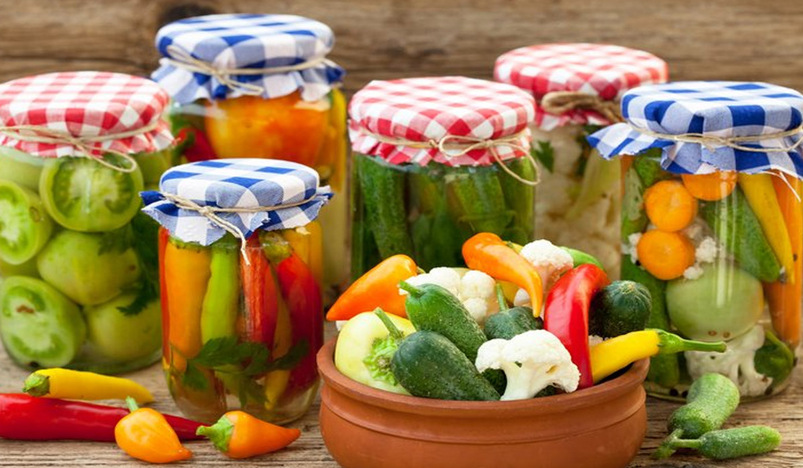
Food preservation tips
Now more than ever, people are purchasing canned or frozen food products with longer shelf lives to cut down on trips to the store. But there are plenty of ways to extend the lives of our groceries and make the most of our shopping budget from the comfort of our very own kitchens.
Chef and TV host Elena Besser is a pro when it comes to stretching the shelf life of her favorite fruits, veggies and herbs. She has tips on how to slow down ripening, flash-freeze healthy produce, triple the longevity of springtime alliums, savor every last bit of those jarred goods and turn nuts into milk and butter.
How to make foods last longer
• Bananas: To prevent over-ripening, place plastic wrap around the stems that hold your banana bunch together. Ethylene gas, which speeds up the ripening process, is released from the stems. So when you cover them, it slows the gas from emitting and keeps your bananas fresher longer. To make them last even longer, wrap each banana stem individually. And remember: You can always keep the peels for surprising uses outside the kitchen.
• Potatoes, onions and garlic: To keep these cooking staples ready to use for a whole month, store them in a cool, dark place in your kitchen and give them a little a breathing room (that is, don't put them in a bag). While some folks may think the fridge is a good spot, it's actually too cold. If stored in the fridge, the starches in the onions, garlic and potatoes begin to convert into sugars, which causes the produce to become softer and soggier faster. Plus, no one wants a fridge that smells like garlic breath.
How to regrow savory items
You can regrow your scallions two or three times after their first use!
For those who are fans of fennel, scallions, leeks and spring onions, there is a simple way to triple their shelf life: regrow them! Here's how to do it.
- Place the vegetable's white roots into a glass of water and place in a window sill. This works most quickly with scallions
- Trim off the green tops to use, save the white and light green parts.
- Place the roots into a glass of room temperature water and place near a well-lit window sill. On just a few days, the scallions (which sprout the fastest) will begin to regrow and you will be able to use them three times over.
How to blanch and freeze produce and herbs
Blanching is the best way to preserve the flavor and color of fresh herbs and produce before freezing them. You can blanch at any time you want, though Besser advises blanching vegetables right away and fresh herbs towards the end of their shelf life.
Blanch and freeze your vegetables to preserve them at peak freshness.
• To blanch: Simply add herbs or vegetables to a pot of salted boiling water, followed by a dunk in an ice bath. For herbs, cook 30 seconds, and for fresh produce, cook 2 to 4 minutes, depending on how thick it is. Once they've cooked, transfer the items to a bowl of ice water to quickly stop the cooking and lock in the bright color.
• To preserve the herbs: After the ice bath, squeeze out the water, chop and store in a container with olive oil in the fridge for up to two weeks, or store chopped herbs in ice cube trays and freeze for up to a month.
• To freeze produce: Drain out any water after the ice bath, pat dry and store in the freezer in a resealable bag.
What to do with other jarred foods (and the brine), oats, nuts and cheese
Some foods have naturally long shelf lives, such as Parmesan cheese, jarred products, oats and nuts. But there are creative things you can do to save money and stretch your food in even further!
• Jarred foods: Foods like anchovies, artichokes, olives, capers and roasted red peppers have a really long shelf life as long as you keep them in the liquid or brine that they come in. And once you finish these foods, don't ditch the brine. That, too, can remain in the fridge until its expiration and used in salad dressings. There are some shockingly tasty recipes to make with pickle brine.
• Parmesan cheese: If you buy chunks of Parmesan cheese instead of pre-ground, it will last three times longer. You can easily grind up the amount of Parmesan cheese you need in a food processor or with a box grater. Then, save the rinds! They add excellent flavor to soups, stews, stock, risotto and pasta sauce.
• Oats: You can use oats for many things beyond oatmeal. Besser enjoys using oats in breads, muffins and cookies. She also uses oats to make pie crust, oat milk and pancakes.
• Nuts: You can "milk" walnuts, cashews, almonds — you name it — for all they've got by making, well, milk — and butter, too!
.jpg)
Qatar Secures Place Among the World's Top 10 Wealthiest Nations
.jpg)
Hamad International Airport Witnesses Record Increase in Passenger Traffic

Saudi Arabia: Any visa holder can now perform Umrah

What are Qatar's Labour Laws on Annual Leave?
Leave a comment